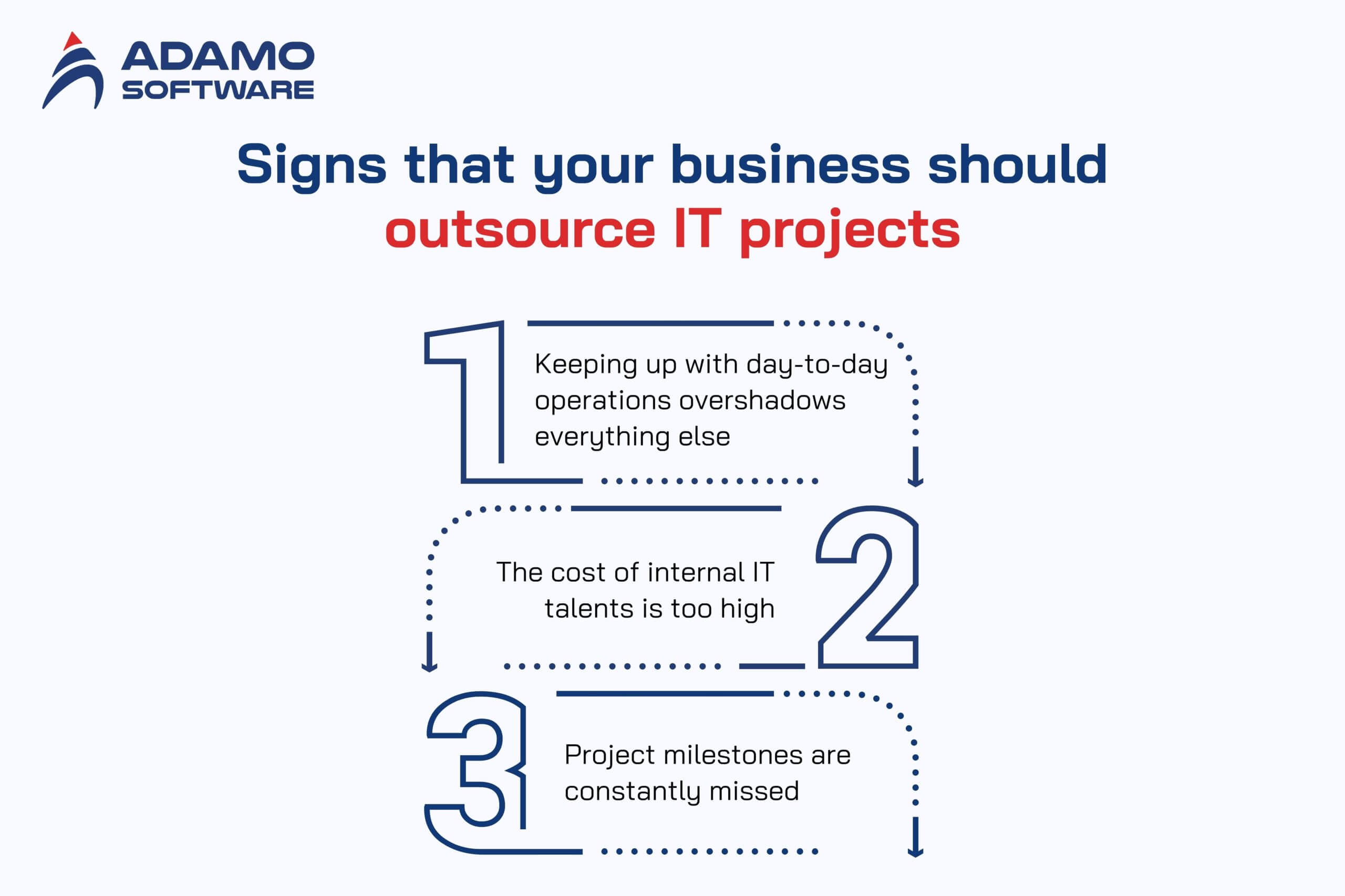IT project outsourcing: Tips to identify when you need to outsource

In today’s cutthroat business world, IT project outsourcing is critical. It helps businesses get top-notch technological support and increase business efficiency. Clutch research has shown that over 37% of small businesses outsource at least one business process, with IT services topping the list. The number is even higher, with around 90% of Fortune 500 companies outsourcing at least part of their IT needs. And for good reason.
Outsourcing an IT project allows you to build software or support IT-based business processes without making a large investment or putting additional pressure on your internal team. Regardless of the size of your company or the complexity of the project, businesses have instant access to the most skilled IT talent on the market.
However, outsourcing an entire IT project outsourcing to another team can be difficult. To help you navigate the complexities and create a secure outsourcing strategy, we’ll provide tips for deciding whether to outsource and secure your IT project outsourcing from day one. Read on to learn how to get the most out of your outsourcing projects.
I. What is IT project outsourcing?
In simple words, IT projects outsourcing is using a third-party company or external team to support your IT-related projects.
Outsourcing IT projects can target specific tasks, projects, and technologies—or even an entire business unit, depending on your business needs. You can hire them for selected phases or the whole process.
IT project outsourcing can provide highly qualified talent to fill the skill gaps within your internal team faster and more cost-effectively than traditional recruitment methods. Additionally, it can also help in better resource allocation for your team to focus on core business activities.
Also read: Benefits of outsourcing IT projects: Do the Pros Outweigh the Cons?
II. Common industry that IT project outsourcing may involve in

Healthcare: Outsourced resources can assist in developing and managing IT projects for electronic health records (EHR) systems. Other software, such as patient management and telehealth services, are available.
Finance and Banking: Outsourcing IT projects can assist organizations in implementing financial management systems, fintech applications, and security solutions.
Retail: Assist retailers in creating e-commerce platforms, supply chain management solutions, and customer relationship management (CRM) systems.
Manufacturing: Outsourcing it projects can help automate manufacturing processes and inventory management systems and integrate IoT for smart manufacturing.
Education: An external IT outsourcing team can assist educators in developing e-learning platforms, online learning portals, student information systems, and virtual classroom technology.
III. Popular types of IT project outsourcing models

Here are some common types of IT project outsourcing services. The terminology may vary from one IT project outsourcing provider to another. You can look at the definition and its features to see which fits your business needs and what you should expect when discussing with potential outsourcing service providers.
1. Offshore Development Center (ODC)
An offshore development center (ODC) refers to a team of specialized developers based outside the client’s country performing IT services. ODCs are typically established by companies that want to outsource their IT needs to a team of experienced and skilled developers working remotely. Normally, an ODC team will work for only one client company. They are considered an extension of that company’s IT department. However, the client company does not need to worry about other costs for those employees, such as insurance, salaries, working conditions, etc. They only need to pay the service fee to the outsourcing service provider.
One of the main concerns of clients when working with ODCs is security. To address this issue, most reputable ODC teams have strict security protocols. All team members must work in separate areas, providing limited access only to authorized employees. Many ODCs invest more in advanced security methods such as firewalls, encryption, and secure networks to protect client data.
2. Project-Based
While the ODC partnership model is usually long-term, project-based outsourcing teams are built for a single project with a defined scope, time, and budget. Team members in a project-based model can be assigned to work on multiple projects over time. This type of IT project outsourcing contract is suitable for companies that want to outsource a portion of a larger project. They are working under pressure to get the final result as soon as possible. Therefore, a project-based outsourcing model with lose control and a focus on results can be a good combination.
3. Dedicated Team
A dedicated team operates in the same way as an ODC. However, all team members will work at the client’s corporate office. Many companies partly prefer this IT outsourcing model because it is convenient for communication, easy to share workflows, and fits their working style. Due to labor costs and other responsibilities, not all companies can afford to hire a dedicated team for a long period. Meanwhile, ODC teams can function well even when working remotely and can easily scale up in a short period.
IV. Signs that your business should outsource IT projects
It is natural to have many questions about when to outsource your IT projects. If any of these scenarios sound familiar, it may be a sign that you should consider outsourcing.

1. Keeping up with day-to-day operations overshadows everything else
When your internal team constantly deals with issues that arise and cannot escape the fix-it cycles, you have little time to embrace new ideas or technologies. Outsourcing IT projects allows you to tap into untapped potential, freeing up your team to focus on less urgent but more strategically valuable tasks.
2. The Cost of Internal IT Talents Is Too High
For some projects, maintaining an in-house team is too expensive. For example, if you handle internal IT support, you must consider paying for on-call staff, overtime, vacation, and benefits. Outsourcing allows you to pay employees for core competencies while still having access to the same technical expertise at a lower cost.
3. Project Milestones Are Constantly Missed
Regularly meeting your project deadlines with a limited in-house team can be frustrating. Despite your best efforts, your in-house IT efforts result in product launches that must be faster to respond to market changes. In this case, hiring a dedicated team may be the solution you’re looking for.
V. Why Adamo Software can be your partner for IT project outsourcing
When you hire an IT outsourcing team, you will face challenges such as time zone differences, limited face-to-face communication, and cultural differences. These issues can disrupt workflows and affect productivity if not managed properly.

Adamo is one of the leading software development companies in Vietnam. We are confident in providing professional and dedicated software development services. Our team of experienced professionals will help you overcome any challenges and deliver optimal results for your business.
If you have any questions or concerns about hiring a remote development team, please get in touch with us.
FAQs
1. How to Manage and Outsource a Project Effectively?
To manage a project effectively, start with detailed planning. You should define the project scope and goals clearly so that you can plan specifically. Also, regular updates and project management tools like Asana or Jira should be used to keep everyone on the same page. Tools like Worksection and Freedcamp are also great for real-time updates and task management, keeping projects on track.
2. What are the risks of outsourcing IT projects?
Outsourcing IT teams can face major risks such as miscommunication, inconsistent quality, and delays. Choose a partner with proven expertise and a strong reputation to minimize these risks. You also need to conduct regular quality audits and maintain clear communication channels.
Use detailed contracts and set clear standards and terms for goals. Additionally, establish a robust problem-solving process to resolve issues quickly and prevent escalation.
3. What is project outsourcing?
IT project outsourcing is hiring an external team to complete a specific project within a set timeframe and budget. This model is well-suited for projects with clear goals and objectives.
It allows organizations to access specialized skills and complete projects efficiently without hiring new employees for an extended period.
4. What are the four types of outsourcing models?
There are four main types of outsourcing models commonly encountered. Offshore Outsourcing uses a service provider in another country to reduce labor costs. Offshore Outsourcing may involve partners in neighboring or nearby countries to help alleviate some of the challenges of being overseas.
Offshore Outsourcing typically uses suppliers within the same country. This model helps maintain control and cultural consistency. Outsourcing often combines onshore and offshore elements to balance cost, power, and convenience.
5. Why is IT project outsourcing to Vietnam beneficial?
Vietnam is a popular country for outsourcing IT project outsourcing due to its cost-effectiveness, growing tech talent, and government support for the IT sector.
Software companies in Vietnam offer competitive prices and a strong work ethic. In addition, increasing English proficiency makes this an attractive option for IT project outsourcing.











